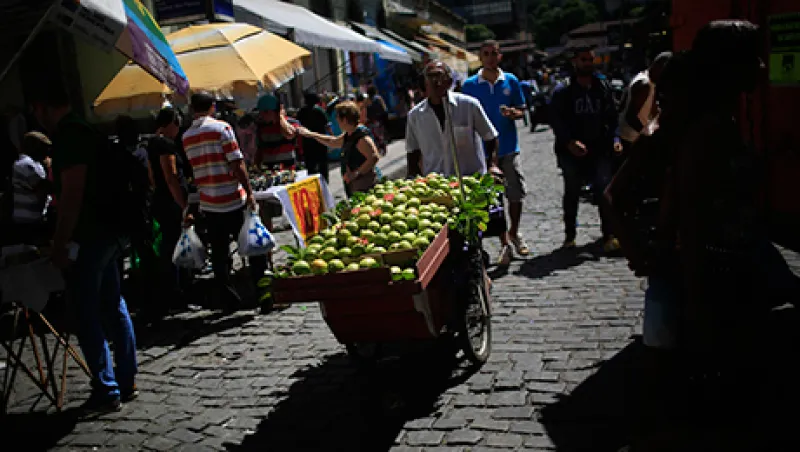This hasn’t been a banner year for Latin American currencies. The Brazilian real has plunged 29 percent against the U.S. dollar, the Mexican peso has slid 12 percent, the Colombian peso 23 percent and the Chilean peso 12 percent.
That’s part of a reversal of a multiyear trend. “Four legs were supporting Latin American and other emerging-markets currencies,” says Win Thin, global head of emerging-markets strategy for Brown Brothers Harriman in New York. They were strong global economic growth, rising commodity prices, low U.S. interest rates and a weak dollar. “It worked for ten years. But now, all four legs have been kicked out,” he says. Policy mistakes in some Latin American countries — particularly Brazil — have exacerbated the problem, say Thin and other analysts. They don’t expect the struggles of Latin American currencies to end any time soon.
The drop in commodity prices, which pushed major commodity indexes to 16-year lows last month, represents “the main reason” for Latin American currency weakness, says Mario Castro, Latin American economist at Nomura Securities in New York.
Oil, which has dropped to a six-year low, accounts for about 55 percent of Colombia’s exports and a substantial portion of the Mexican government’s revenue. Falling oil prices also hurt the Mexican currency because the $16 billion of foreign investment in Mexico’s oil industry that was expected prior to the oil price crash will now probably shrink to $8 billion, says Claudio Irigoyen, head of Latin American fixed-income and foreign exchange strategy for Bank of America Merrill Lynch in New York.
Copper, which has also slumped to a six-year low, makes up about 55 percent of Chile’s exports. Brazil is a major exporter of iron ore, oil and soybeans.
Commodities have slid amid copious supply and sluggish demand — especially from China, which consumes about half of all the world’s industrial commodities, though its economy is rapidly decelerating. Whereas the government reports growth of 7 percent, some outside economists and investors estimate the true figure at 3 to 5 percent. Even Mexico, which doesn’t export much to China, has suffered from the Asian titan’s woes, Irigoyen says. Mexico competes with China for exports to the U.S. China devalued the yuan last month, pushing it down 3 percent versus the dollar. That makes Chinese products cheaper in the U.S. compared with Mexican ones.
The Mexican peso also suffers from investors’ general negative sentiment toward emerging markets, and the currency’s liquidity makes it something of a proxy for emerging markets as a whole. “To hedge a global shock on Latin America, sell Mexico,” Irigoyen says. He and others say Mexican fundamentals actually aren’t that bad. The economy will probably grow 2.2 percent in 2015 and accelerate to 2.8 percent next year, Irigoyen says. Inflation is just 2.8 percent, below the central bank’s target of 3 percent. “There will probably be more pressure on the peso in the short run, but over time it should do better than the others,” he says.
Brazil, though, is a basket case. “It stands out as an example of what happens when you follow the wrong policies,” Thin says. “A few years ago, Brazil had everything going for it.” The prosperity then masked excessive spending and political corruption, however. Now the government faces widespread social unrest. “The government has a lack of credibility to implement fiscal and structural reform, so I don’t see how the economy is going to grow,” Irigoyen says. He forecasts an economic contraction of at least 2.3 percent this year and at least 0.4 percent next year. “The currency will continue to fall, regardless of commodities.”
In Colombia, says Irigoyen, the government may spend as much as 1 percent of its gross domestic product to finance peace agreements with the Revolutionary Armed Forces of Colombia (FARC, in Spanish), the Marxist guerrilla group. That, combined with a current-account deficit, means the currency must fall farther, Irigoyen says. In Chile, meanwhile, the government is pursuing prudent policies, but the commodity swoon trumps other factors, Thin says.
As for the other three support legs that Thin says have been erased (besides rising commodity prices) for Latin American currencies, global economic growth has shrunk since the 2008–’09 financial crisis, the Fed is likely to begin hiking the policy rate before year-end, and the dollar index has climbed 6.7 percent in 2015.
Overall, the outlook is bleak for Latin American currencies. “This adjustment is here to stay,” says Nomura’s Castro. “I don’t see room for a meaningful correction.” If commodity prices continue to fall, the currencies will depreciate further. To be sure, if commodities stabilize or rebound, the Mexican and Chilean pesos can outperform their brethren, reflecting the relative strength of the two nations’ economic fundamentals compared with other countries in the region, he says.
In any case, the days of making easy money going long Latin American currencies are over.
Get more on emerging markets and on foreign exchange.







